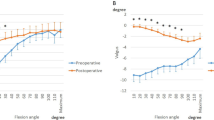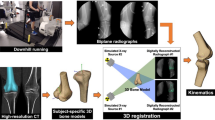Abstract
Purpose
Counteracting posterior translation of the tibia with an anterior force on the posterior proximal tibia has been demonstrated clinically to improve posterior knee laxity following posterior cruciate ligament (PCL) injury. This study quantified forces applied to the posterior proximal tibia by two knee braces designed for treatment of PCL injuries.
Methods
The forces applied by two knee braces to the posterior proximal tibia and in vivo three-dimensional knee kinematics of six adult, male, healthy volunteer subjects (mean ± standard deviation: height, 182.5 ± 5.2 cm; body mass, 83.2 ± 9.3 kg; body mass index, 24.9 ± 1.5 kg/m2; age, 25.8 ± 2.9 years) were measured using a custom pressure mapping technique and traditional surface marker motion capture techniques, while subjects performed three functional activities. The activities included seated unloaded knee flexion, squatting, and stair descent in a new generation dynamic force (DF) PCL brace and a static force (SF) PCL brace.
Results
During unloaded flexion at the lowest force level setting, the force applied by the DF brace increased as a function of flexion angle (slope = 0.7 N/°; p < 0.001) compared to the SF brace effect. Force applied by the SF brace did not significantly change as a function of flexion angle (slope = 0.0 N/°; n.s.). By 45° of flexion, the average force applied by the DF brace (48.1 N) was significantly larger (p < 0.001) than the average force applied by the SF brace (25.0 N). The difference in force continued to increase as flexion angle increased. During stair descent, average force (mean ± standard deviation) at toe off was significantly higher (p = 0.013) for the DF brace (78.7 ± 21.6 N) than the SF brace (37.3 ± 7.2 N). Similar trends were observed for squatting and for the higher force level settings.
Conclusions
The DF brace applied forces to the posterior proximal tibia that dynamically increased with increased flexion angle. Additionally, the DF brace applied significantly larger forces at higher flexion angles compared to the SF brace where the PCL is known to experience larger in situ forces. Clinical studies are necessary to determine whether the loading characteristics of the DF brace, which more closely replicated the in situ loading profile of the native PCL, results in long-term improved posterior knee laxity following PCL injury.
Level of evidence
II.



Similar content being viewed by others
References
Ahn JH, Lee SH, Choi SH, Wang JH, Jang SW (2011) Evaluation of clinical and magnetic resonance imaging results after treatment with casting and bracing for the acutely injured posterior cruciate ligament. Arthroscopy 27:1679–1687
Anderson CJ, Ziegler CG, Wijdicks CA, Engebretsen L, LaPrade RF (2012) Arthroscopically pertinent anatomy of the anterolateral and posteromedial bundles of the posterior cruciate ligament. J Bone Jt Surg Am 94:1936–1945
Clancy WG Jr, Shelbourne KD, Zoellner GB, Keene JS, Reider B, Rosenberg TD (1983) Treatment of knee joint instability secondary to rupture of the posterior cruciate ligament: report of a new procedure. J Bone Jt Surg Am 65:310–322
Covey CD, Sapega AA (1993) Injuries of the posterior cruciate ligament. J Bone Jt Surg Am 75:1376–1386
DeFrate LE, Gill TJ, Li G (2004) In vivo function of the posterior cruciate ligament during weightbearing knee flexion. Am J Sports Med 32:1923–1928
Escamilla RF, Zheng N, MacLeod TD, Imamura R, Edwards WB, Hreljac A, Fleisig GS, Wilk KE, Moorman CT, Paulos L, Andrews JR (2010) Cruciate ligament tensile forces during the forward and side lunge. Clin Biomech (Bristol, Avon) 25:213–221
Fanelli GC (1993) Posterior cruciate ligament injuries in trauma patients. Arthroscopy 9:291–294
Fanelli GC, Edson CJ (1995) Posterior cruciate ligament injuries in trauma patients: part II. Arthroscopy 11:526–529
Fowler PJ, Messieh SS (1987) Isolated posterior cruciate ligament injuries in athletes. Am J Sports Med 15:553–557
Fox RJ, Harner CD, Sakane M, Carlin GJ, Woo SL (1998) Determination of the in situ forces in the human posterior cruciate ligament using robotic technology: a cadaveric study. Am J Sports Med 26:395–401
Harner CD, Janaushek MA, Kanamori A, Yagi M, Vogrin TM, Woo SL (2000) Biomechanical analysis of a double-bundle posterior cruciate ligament reconstruction. Am J Sports Med 28:144–151
Iwata S, Suda Y, Nagura T, Matsumoto H, Otani T, Toyama Y (2007) Dynamic instability during stair descent in isolated PCL-deficient knees: what affects abnormal posterior translation of the tibia in PCL-deficient knees? Knee Surg Sports Traumatol Arthrosc 15:705–711
Jacobi M, Reischl N, Wahl P, Gautier E, Jakob RP (2010) Acute isolated injury of the posterior cruciate ligament treated by dynamic anterior drawer brace: a preliminary report. J Bone Jt Surg Br 92:1381–1384
Jansson KS, Costello KE, O’Brien L, Wijdicks CA, Laprade RF (2013) A historical perspective of PCL bracing. Knee Surg Sports Traumatol Arthrosc 21:1064–1070
Jung YB, Tae SK, Lee YS, Jung HJ, Nam CH, Park SJ (2007) Active non-operative treatment of acute isolated posterior cruciate ligament injury with cylinder cast immobilization. Knee Surg Sports Traumatol Arthrosc 16:729–733
Keller PM, Shelbourne KD, McCarroll JR, Rettig AC (1993) Nonoperatively treated isolated posterior cruciate ligament injuries. Am J Sports Med 21:132–136
Kennedy NI, Laprade RF, Goldsmith MT, Faucett SC, Rasmussen MT, Coatney GA, Engebretsen L, Wijdicks CA (2014) Posterior cruciate ligament graft fixation angles, part 1: biomechanical evaluation of anatomic single-bundle reconstruction. Am J Sports Med. doi:10.1177/0363546514541225
Kennedy NI, Wijdicks CA, Goldsmith MT, Michalski MP, Devitt BM, Aroen A, Engebretsen L, LaPrade RF (2013) Kinematic analysis of the posterior cruciate ligament, part 1: the individual and collective function of the anterolateral and posteromedial bundles. Am J Sports Med 41:2828–2838
Li G, DeFrate LE, Sun H, Gill TJ (2004) In vivo elongation of the anterior cruciate ligament and posterior cruciate ligament during knee flexion. Am J Sports Med 32:1415–1420
Lopez-Vidriero E, David SA, Johnson DH (2010) Initial evaluation of posterior cruciate ligament injuries: history, physical examination, imaging studies, surgical and nonsurgical indications. Sports Med Arthrosc 18:230–237
Myers CA, Torry MR, Shelburne KB, Giphart JE, LaPrade RF, Woo SL, Steadman JR (2012) In vivo tibiofemoral kinematics during 4 functional tasks of increasing demand using biplane fluoroscopy. Am J Sports Med 40:170–178
Papannagari R, DeFrate LE, Nha KW, Moses JM, Moussa M, Gill TJ, Li G (2007) Function of posterior cruciate ligament bundles during in vivo knee flexion. Am J Sports Med 35:1507–1512
Parolie JM, Bergfeld JA (1986) Long-term results of nonoperative treatment of isolated posterior cruciate ligament injuries in the athlete. Am J Sports Med 14:35–38
Shelbourne KD, Davis TJ, Patel DV (1999) The natural history of acute, isolated, nonoperatively treated posterior cruciate ligament injuries: a prospective study. Am J Sports Med 27:276–283
Spiridonov SI, Slinkard NJ, LaPrade RF (2011) Isolated and combined grade-III posterior cruciate ligament tears treated with double-bundle reconstruction with use of endoscopically placed femoral tunnels and grafts: operative technique and clinical outcomes. J Bone Jt Surg Am 93:1773–1780
Strobel MJ, Weiler A, Schulz MS, Russe K, Eichhorn HJ (2002) Fixed posterior subluxation in posterior cruciate ligament-deficient knees: diagnosis and treatment of a new clinical sign. Am J Sports Med 30:32–38
Wijdicks CA, Kennedy NI, Goldsmith MT, Devitt BM, Michalski MP, Aroen A, Engebretsen L, LaPrade RF (2013) Kinematic analysis of the posterior cruciate ligament, part 2: a comparison of anatomic single- versus double-bundle reconstruction. Am J Sports Med 41:2839–2848
Yoon KH, Park SW, Lee SH, Kim MH, Park SY, Oh H (2013) Does cast immobilization contribute to posterior stability after posterior cruciate ligament reconstruction? Arthroscopy 29:500–506
Acknowledgments
The authors acknowledge Kyle Jansson for his contributions to technology development and planning and design of this study. The authors acknowledge Grant Dornan, MSc for his contributions to the statistical analysis in this study and Angelica Wedell for the photography presented in this study.
Conflict of interest
Össur provided unrestricted in-kind donations of the braces utilized in this study. Dr. LaPrade is a consultant for Arthrex and Smith & Nephew.
Author information
Authors and Affiliations
Corresponding author
Rights and permissions
About this article
Cite this article
LaPrade, R.F., Smith, S.D., Wilson, K.J. et al. Quantification of functional brace forces for posterior cruciate ligament injuries on the knee joint: an in vivo investigation. Knee Surg Sports Traumatol Arthrosc 23, 3070–3076 (2015). https://doi.org/10.1007/s00167-014-3238-4
Received:
Accepted:
Published:
Issue Date:
DOI: https://doi.org/10.1007/s00167-014-3238-4




